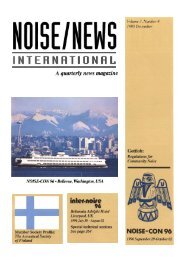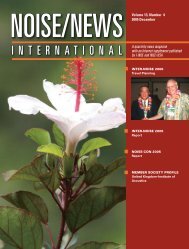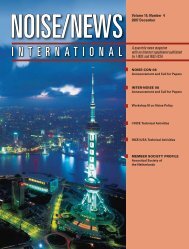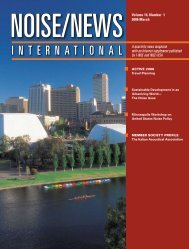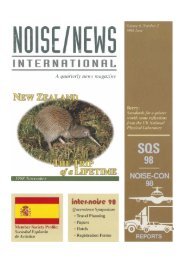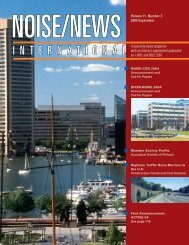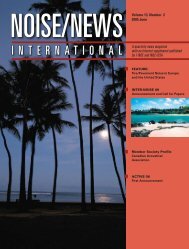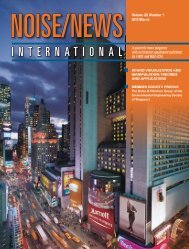Volume 6, Number 4, December, 1998 - Noise News International
Volume 6, Number 4, December, 1998 - Noise News International
Volume 6, Number 4, December, 1998 - Noise News International
Create successful ePaper yourself
Turn your PDF publications into a flip-book with our unique Google optimized e-Paper software.
Feature<br />
<strong>Noise</strong> Control Standards for Machinery<br />
and Workplaces<br />
Hans Lazarus, Bundesanstalt fur Arbeitsschutz und Arbeitsmedizin, Dortmund, Germany<br />
Dorit Zimmermann, KAN Secretariat, Sankt Augustin, Germany<br />
HansLazarus isascientistanddirector<br />
oftheteamfor noisecontrol<br />
at the Bundesanstalt fur Arbeitsschutz<br />
und Arbeitsmedizin<br />
Dortmund (Federal Institute of<br />
Occupational Health and Safety).<br />
He received hiseducation incommunications<br />
engineering from the<br />
Technical Universities inDresden<br />
and Berlin. He wrote hisdissertation underthe directionof<br />
Professor Cremer of the Institute for Teclmical<br />
Acoustics attheTechnical University inWest Berlin. He<br />
worked in committees of national (NALS), European<br />
(CENTC277), andinternational (ISO TC43) Technical<br />
Committees of Acoustics. His main subjects are<br />
nOise emission andreduction ofmachines, sounddistribur/on<br />
in workrooms, noiseassessment at workplace,<br />
and speech communication.<br />
Since completing her studies in<br />
chemical engineering at the University<br />
of Dortmund, Germany in<br />
the autumn of 7995, Dorit Zimmermann<br />
hasbeenaproject manager<br />
in the Department for<br />
Ergonomics and Health Protection<br />
within the Secretariat of the<br />
Commission for occupational<br />
health, safety, andstandardization (KAN). KANwasset<br />
up in 1994to establish a common national position of<br />
theGerman OH&Sinstitutions andsocialpartners and<br />
to assert thisposition on OH&S matters in European<br />
standardization at an early stage. KANhas to identifY<br />
theinterfaces between Directives (protection aims) and<br />
the standards (technical specifications) and act upon<br />
themandates issued bytheEuropean Commission. Ms.<br />
Zimmermann is the project manager for noise, PPE,<br />
SCJ1~en work, and lighting in the relevant KANexperts<br />
network for these subjects.<br />
This is an edited version ofan article with the same<br />
name that appeared in the European Safety <strong>News</strong>letter.<br />
8-12, <strong>1998</strong> April-May.-Ed.<br />
Introduction<br />
A variety of international and European standards<br />
concerned with various parameters relevant to noise<br />
control are under development in order to properly<br />
implement the machinery directive 89/392. 1,2<br />
Standards covering machinery, sound insulation<br />
products, workrooms, and workplaces are already in<br />
place. This article considers the standardization<br />
concept which underlies this standards-making program.<br />
It also highlights deficiencies which are apparent<br />
to employers and safety specialists<br />
depending on standards to assist them in implementing<br />
specific noise control measures. The quality of<br />
machine-specific standards needs to be improved if<br />
they are to bring the intended benefits for occupational<br />
health and safety.<br />
This article presents the results of a project commissioned<br />
by Germany's Commission for Occupational<br />
Health, Safety and Standardization, KAN.3<br />
The project was carried out by the Bundesanstalt ftir<br />
Arbeitsschutz und Arbeitsmedizin (BAuA) in cooperation<br />
with NA Akustik, Larmminderung und<br />
Schwingungstechnik, NALS,4 and the lTD technical<br />
documentation center. 5<br />
The objective of the project was to assess the<br />
need for standards-making for noise control, as required<br />
by the machinery directive 89/392, and to<br />
consider the control concept on which this standards-making<br />
program is based. The relevant standards<br />
encompass technical noise sources, various<br />
modes of sound propagation, and the consequences<br />
of noise exposure at the workplace. This standardization<br />
concept for noise control is derived from the<br />
existing European Union (EU) directives, national<br />
implementation regulations, and the needs of occupational<br />
health and safety practice.<br />
For the standardization concept to be effective,<br />
methods must be available for quantifying the<br />
acoustical characteristics of machines (taking into<br />
account how they are being operated), of sound insulation<br />
products, and of workplaces themselves.<br />
The relevant parameters and the methods to be used<br />
for assigning values to them are described in the<br />
<strong>1998</strong> <strong>December</strong><br />
<strong>Noise</strong>/<strong>News</strong> <strong>International</strong> 201



